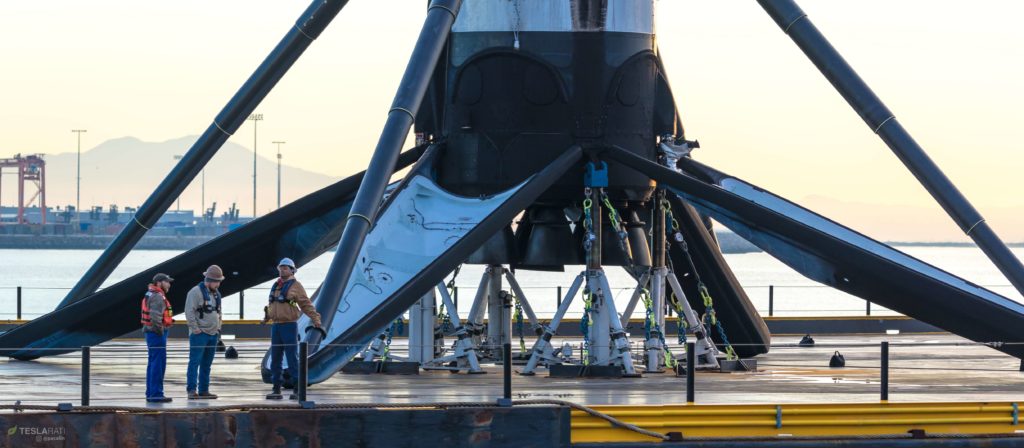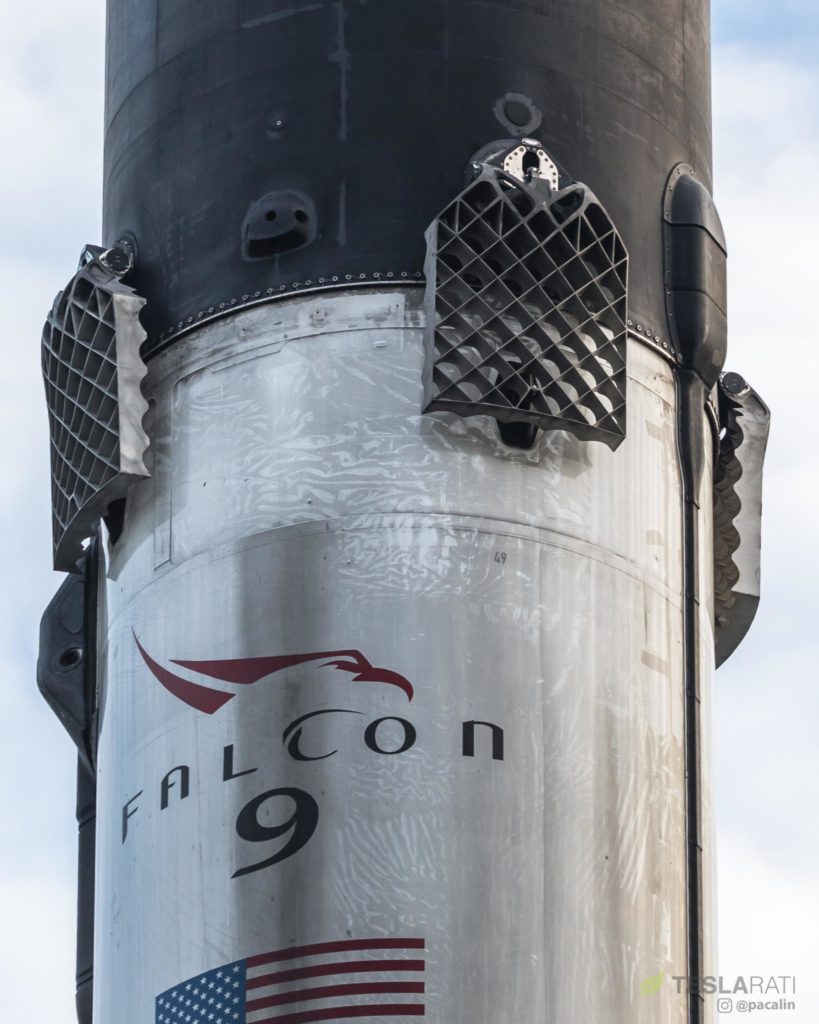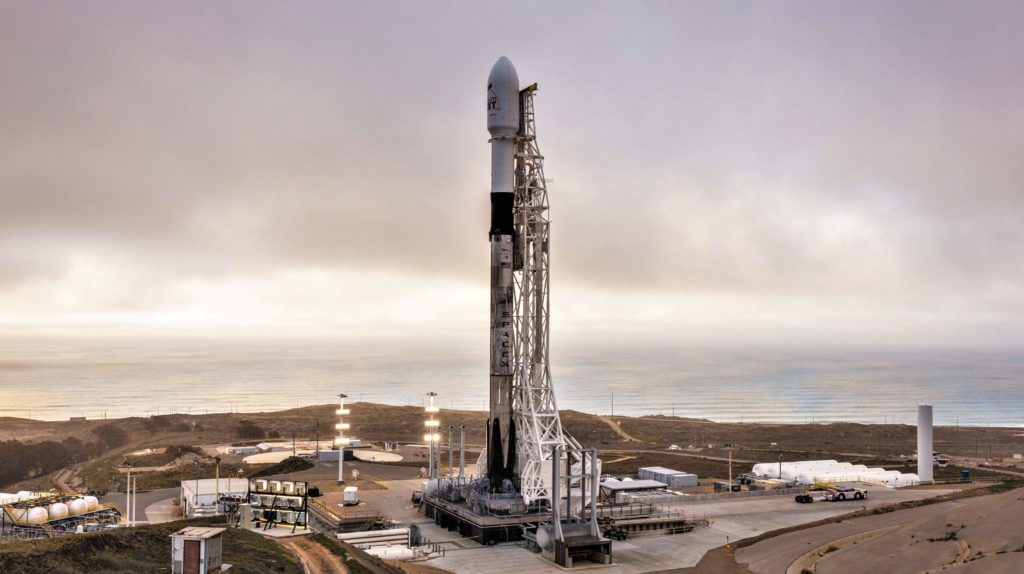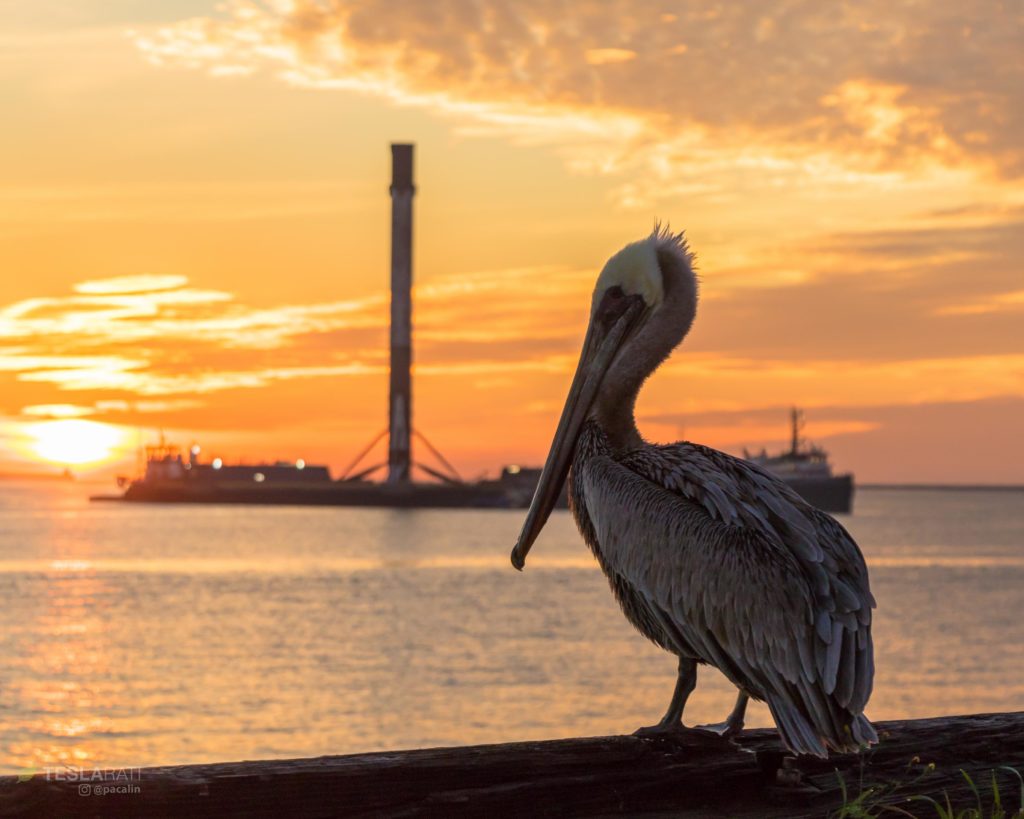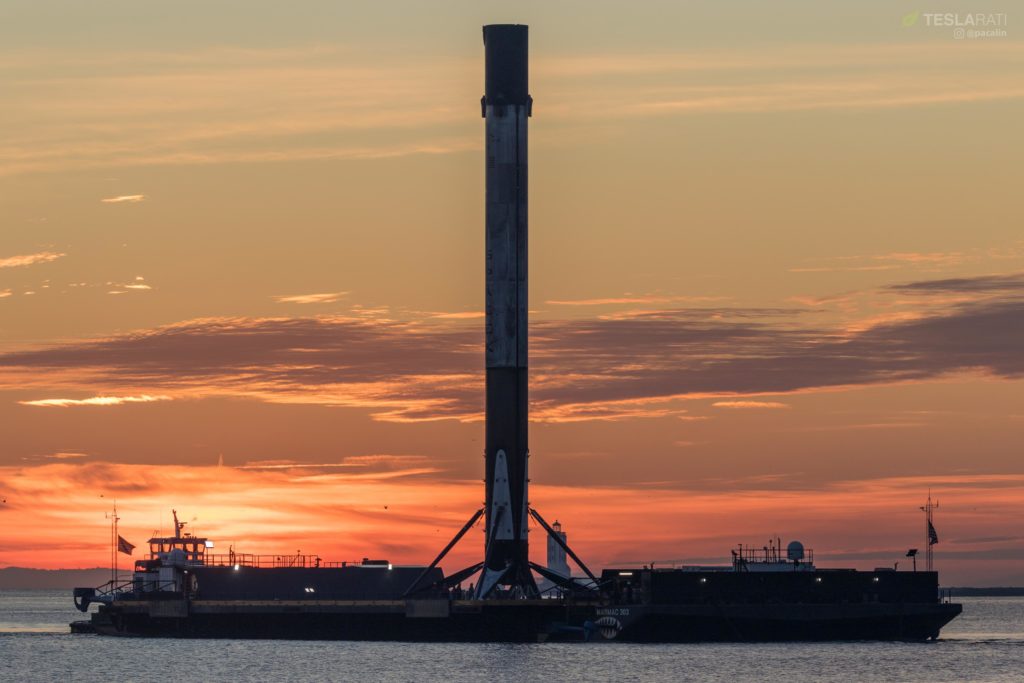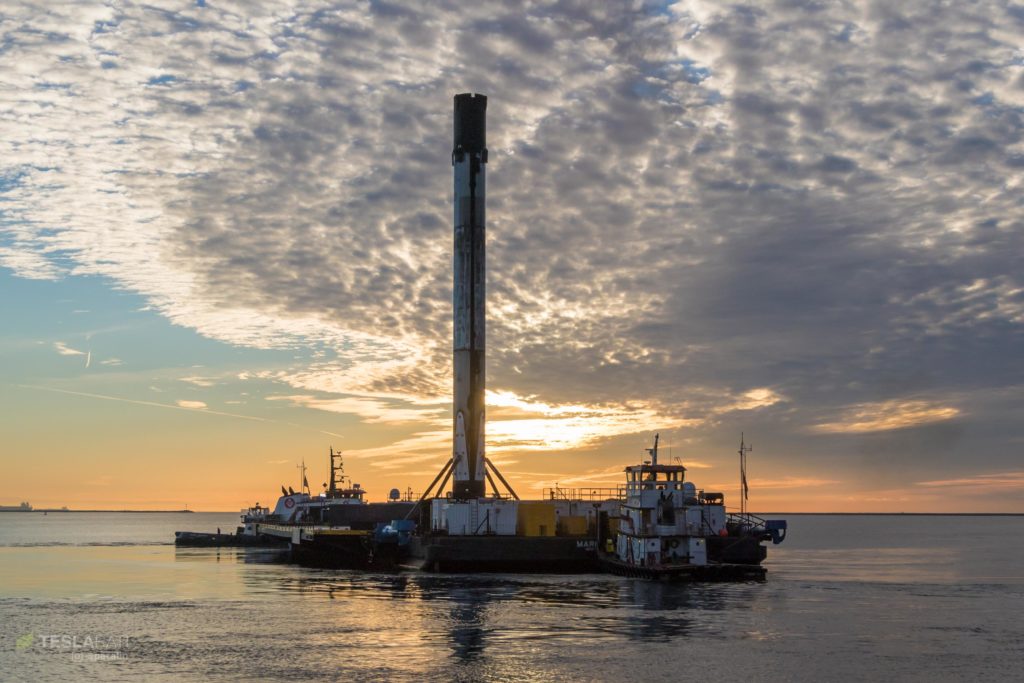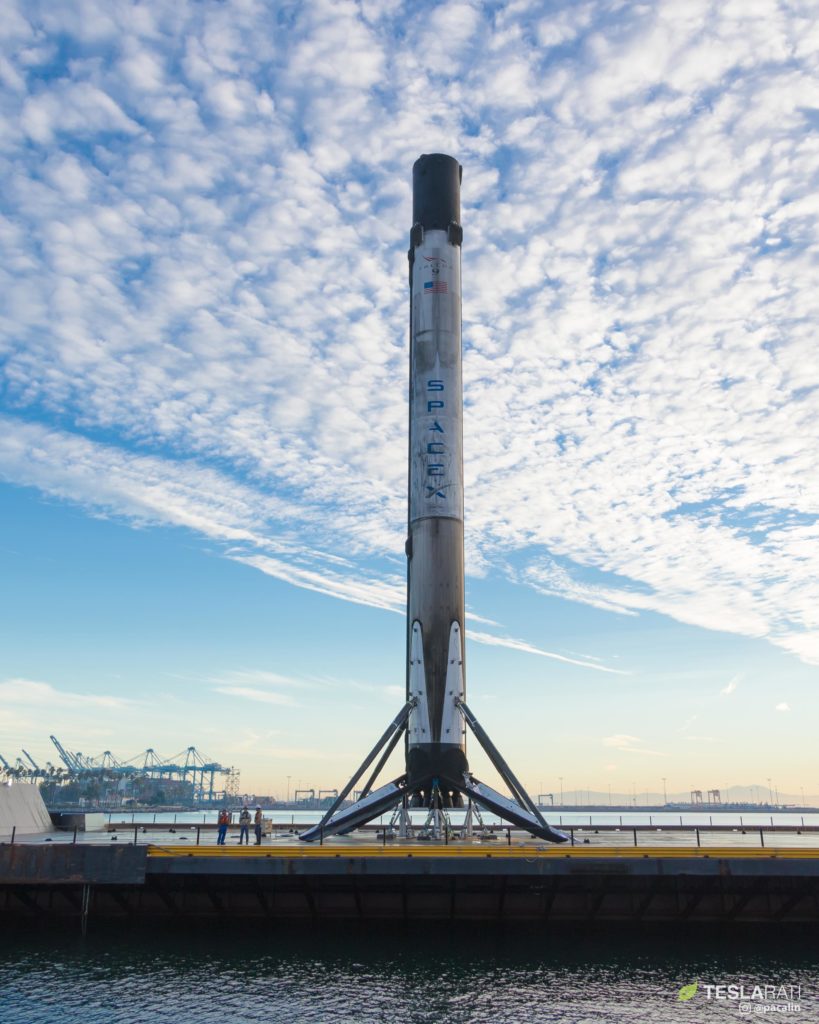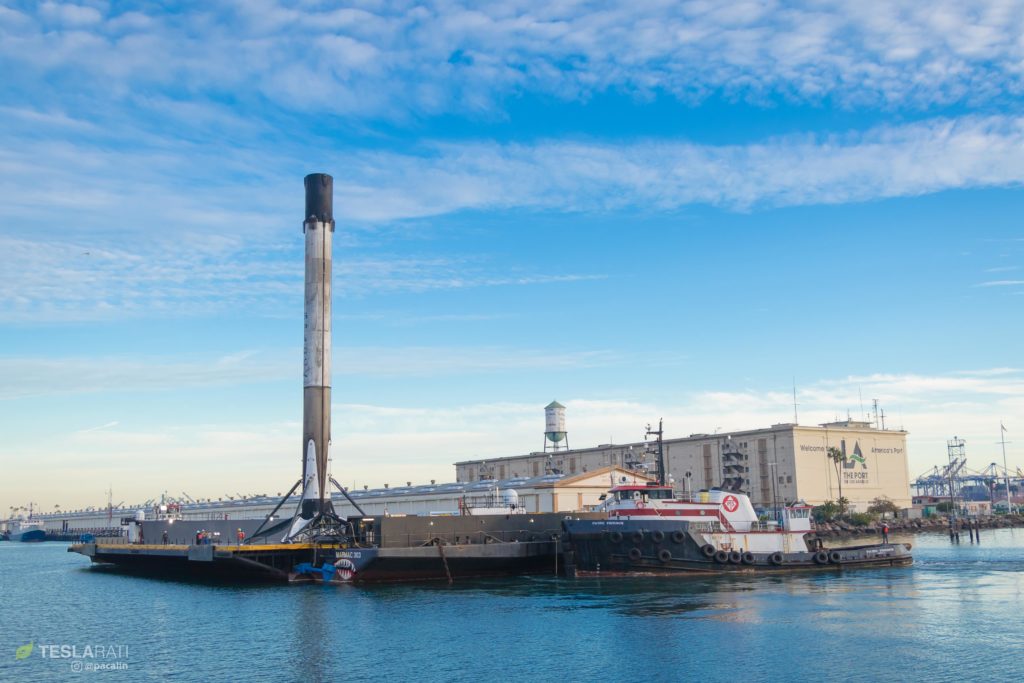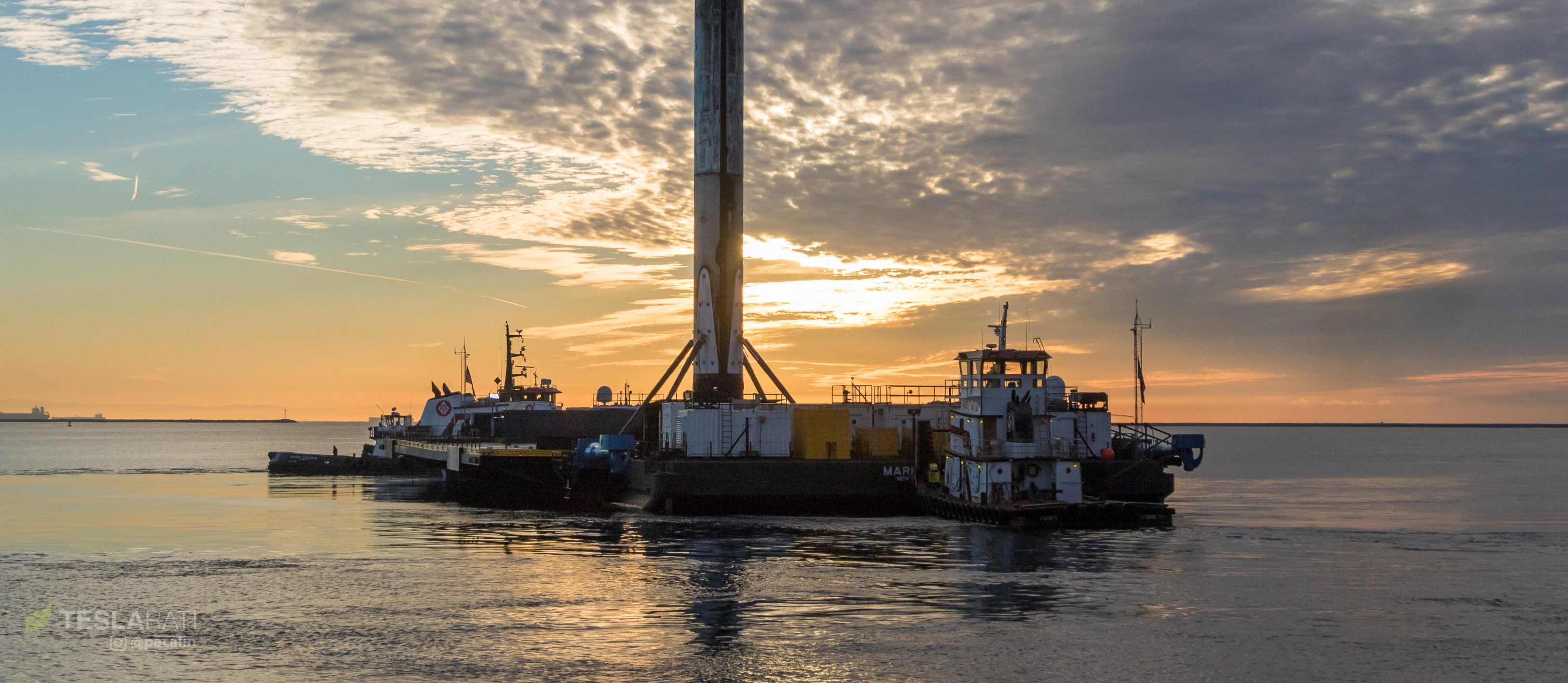

News
SpaceX Falcon 9 Block 5 booster ends launch #2 with spectacular dawn return
SpaceX Falcon 9 booster B1049 has completed its second successful launch and landing with a spectacular dawn return to Port of Los Angeles, where engineers and technicians will work to remove the rocket’s grid fins and landing legs and prepare the vehicle for transport to the company’s Hawthorne, CA factory and refurbishment facilities.
Once post-recovery processing is complete and B1049 is safe and snug inside one of SpaceX’s refurbishment facilities, the booster can be expected to be ready to perform its next (third) orbital-class mission perhaps just 2-3 months from now, whether or not there is a mission that needs its support.
Just Read the Instructions has now docked, carrying twice-flown Iridium-8 booster. Beautiful sunrise arrival. #spacex pic.twitter.com/OAi77wm3XT
— Pauline Acalin (@w00ki33) January 13, 2019
Just ~48 hours after the Block 5 booster’s second successful launch and landing, this time aboard drone ship Just Read The Instructions (JRTI) after supporting the historic Iridium-8 mission, JRTI pulled into Port of Los Angeles with Falcon 9 in tow, backlit by a picturesque California sunrise. In September 2018, the same booster (B1049) successfully completed its launch debut from SpaceX’s LC-40 launch pad in Cape Canaveral, Florida before landing safely aboard drone ship Of Course I Still Love You (OCISLY).
This marks the second time ever that a Falcon 9 booster has launched from both coasts (Cape Canaveral, FL and Vandenberg, CA) and landed on both SpaceX drone ships (JRTI and OCISLY), an event that will likely become increasingly common as the company’s growing fleet of Falcon 9 Block 5 boosters become increasingly flexible and interchangeable. It’s also equally possible that – over time – a sort of regional fleet of Falcon 9s will ultimately accumulate at each of SpaceX’s three launch pads, ensuring that there is always a rocket ready and waiting to launch a customer payload with short notice and minimal production or refurbishment-related delays.
- Falcon 9 B1049 and a few SpaceX recovery technicians serve as an excellent since of scale for launch photos. (Pauline Acalin)
- Falcon 9 B1049 returned to Port of Los Angeles after its second successful launch and landing in four months. (Pauline Acalin)
- Falcon 9 B1049 seen vertical at SLC-4E prior to its second launch, the eighth and final Iridium NEXT mission. (SpaceX)
Among many of Falcon 9’s almost sculpture-like qualities, Teslarati photographer Pauline Acalin’s photos of the booster’s return exemplify just how reliably unperturbed Block 5 appears after performing multiple orbital-class launches, far from a rocket that traveled to ~90 km (~56 mi) while reaching speeds of 1.9 kilometers per second (6830 km/h, 4300 mph). SpaceX now reliably reuses Falcon 9’s titanium grid fins and landing legs with little to no refurbishment or touching up between launches and should eventually be able to retract the rocket’s legs after recovery, further cutting down on processing and refurbishment times.
Greater reusability, greater reliability?
As of today, it’s unclear how big of a role Falcon 9 Block 5 booster refurbishment has played into several hardware-readiness-related delays to several recent flight-proven Falcon 9 launches (SSO-A, SAOCOM 1A, and Iridium-8), but it is ultimately a fundamental reality of all manufacturing that rushing or ‘expediting’ work will typically hurt product quality and reliability and generally widen the cracks that mistakes can slip through. Interestingly, having a truly large fleet of flight-proven Falcon 9 Block 5 rockets on hand could dramatically improve the overall launch-readiness of Falcon 9 and Falcon Heavy and minimize chances of processing delays across the board.
SpaceX employees may already be to a point where they can plausible take stock of the company’s already-significant fleet of flight-proven Falcon 9s (B1046-B1049) to decide which booster is closest to launch-readiness before assigning it to a given mission. With four proven boosters on hand as of January 2019, options are fairly limited and regionality is likely to factor heavily into which booster launches which mission – there is no real cushion if problems arise with a given rocket or its preceding launch suffers its own delays. However, once that Falcon fleet grows to something like 10 or 15 booster, SpaceX could conceivably be able to guarantee booster availability regardless of prior launch delays or a given rocket’s condition after landing.
- (Pauline Acalin)
- A bittersweet sunrise as Falcon 9 B1049 arrives in port. (Pauline Acalin)
- (Pauline Acalin)
- (Pauline Acalin)
This may well be far less sexy than SpaceX’s ultimate goal of drop-of-the-pin, 24-hour reusability for Falcon and BFR boosters, but the fundamental fact of the matter is that the company may well be able to derive a vast majority of that practice’s value by simply having a large, well-kept fleet of Falcon 9 boosters that are at least moderately reusable. For a hefty chunk of the probable near-term future, a large fleet of rockets each capable of launching every 30-60 days would likely be able to support launch cadences that are currently unprecedented for a single company or rocket (i.e. dozens of launches per year).
Time is money, of course, so minimizing the turnaround time of Falcon boosters will ultimately remain a major priority, especially as the prospect of Starlink launches loom.
For prompt updates, on-the-ground perspectives, and unique glimpses of SpaceX’s rocket recovery fleet check out our brand new LaunchPad and LandingZone newsletters!
News
Tesla cleared in Canada EV rebate investigation
Tesla has been cleared in an investigation into the company’s staggering number of EV rebate claims in Canada in January.

Canadian officials have cleared Tesla following an investigation into a large number of claims submitted to the country’s electric vehicle (EV) rebates earlier this year.
Transport Canada has ruled that there was no evidence of fraud after Tesla submitted 8,653 EV rebate claims for the country’s Incentives for Zero-Emission Vehicles (iZEV) program, as detailed in a report on Friday from The Globe and Mail. Despite the huge number of claims, Canadian authorities have found that the figure represented vehicles that had been delivered prior to the submission deadline for the program.
According to Transport Minister Chrystia Freeland, the claims “were determined to legitimately represent cars sold before January 12,” which was the final day for OEMs to submit these claims before the government suspended the program.
Upon initial reporting of the Tesla claims submitted in January, it was estimated that they were valued at around $43 million. In March, Freeland and Transport Canada opened the investigation into Tesla, noting that they would be freezing the rebate payments until the claims were found to be valid.
READ MORE ON ELECTRIC VEHICLES: EVs getting cleaner more quickly than expected in Europe: study
Huw Williams, Canadian Automobile Dealers Association Public Affairs Director, accepted the results of the investigation, while also questioning how Tesla knew to submit the claims that weekend, just before the program ran out.
“I think there’s a larger question as to how Tesla knew to run those through on that weekend,” Williams said. “It doesn’t appear to me that we have an investigation into any communication between Transport Canada and Tesla, between officials who may have shared information inappropriately.”
Tesla sales have been down in Canada for the first half of this year, amidst turmoil between the country and the Trump administration’s tariffs. Although Elon Musk has since stepped back from his role with the administration, a number of companies and officials in Canada were calling for a boycott of Tesla’s vehicles earlier this year, due in part to his association with Trump.
News
Tesla Semis to get 18 new Megachargers at this PepsiCo plant
PepsiCo is set to add more Tesla Semi Megachargers, this time at a facility in North Carolina.

Tesla partner PepsiCo is set to build new Semi charging stations at one of its manufacturing sites, as revealed in new permitting plans shared this week.
On Friday, Tesla charging station scout MarcoRP shared plans on X for 18 Semi Megacharging stalls at PepsiCo’s facility in Charlotte, North Carolina, coming as the latest update plans for the company’s increasingly electrified fleet. The stalls are set to be built side by side, along with three Tesla Megapack grid-scale battery systems.
The plans also note the faster charging speeds for the chargers, which can charge the Class 8 Semi at speeds of up to 1MW. Tesla says that the speed can charge the Semi back to roughly 70 percent in around 30 minutes.
You can see the site plans for the PepsiCo North Carolina Megacharger below.

Credit: PepsiCo (via MarcoRPi1 on X)

Credit: PepsiCo (via MarcoRPi1 on X)
READ MORE ON THE TESLA SEMI: Tesla to build Semi Megacharger station in Southern California
PepsiCo’s Tesla Semi fleet, other Megachargers, and initial tests and deliveries
PepsiCo was the first external customer to take delivery of Tesla’s Semis back in 2023, starting with just an initial order of 15. Since then, the company has continued to expand the fleet, recently taking delivery of an additional 50 units in California. The PepsiCo fleet was up to around 86 units as of last year, according to statements from Semi Senior Manager Dan Priestley.
Additionally, the company has similar Megachargers at its facilities in Modesto, Sacramento, and Fresno, California, and Tesla also submitted plans for approval to build 12 new Megacharging stalls in Los Angeles County.
Over the past couple of years, Tesla has also been delivering the electric Class 8 units to a number of other companies for pilot programs, and Priestley shared some results from PepsiCo’s initial Semi tests last year. Notably, the executive spoke with a handful of PepsiCo workers who said they really liked the Semi and wouldn’t plan on going back to diesel trucks.
The company is also nearing completion of a higher-volume Semi plant at its Gigafactory in Nevada, which is expected to eventually have an annual production capacity of 50,000 Semi units.
Tesla executive teases plan to further electrify supply chain
News
Tesla sales soar in Norway with new Model Y leading the charge
Tesla recorded a 54% year-over-year jump in new vehicle registrations in June.

Tesla is seeing strong momentum in Norway, with sales of the new Model Y helping the company maintain dominance in one of the world’s most electric vehicle-friendly markets.
Model Y upgrades and consumer preferences
According to the Norwegian Road Federation (OFV), Tesla recorded a 54% year-over-year jump in new vehicle registrations in June. The Model Y led the charge, posting a 115% increase compared to the same period last year. Tesla Norway’s growth was even more notable in May, with sales surging a whopping 213%, as noted in a CNBC report.
Christina Bu, secretary general of the Norwegian EV Association (NEVA), stated that Tesla’s strong market performance was partly due to the updated Model Y, which is really just a good car, period.
“I think it just has to do with the fact that they deliver a car which has quite a lot of value for money and is what Norwegians need. What Norwegians need, a large luggage space, all wheel drive, and a tow hitch, high ground clearance as well. In addition, quite good digital solutions which people have gotten used to, and also a charging network,” she said.
Tesla in Europe
Tesla’s success in Norway is supported by long-standing government incentives for EV adoption, including exemptions from VAT, road toll discounts, and access to bus lanes. Public and home charging infrastructure is also widely available, making the EV ownership experience in the country very convenient.
Tesla’s performance in Europe is still a mixed bag, with markets like Germany and France still seeing declines in recent months. In areas such as Norway, Spain, and Portugal, however, Tesla’s new car registrations are rising. Spain’s sales rose 61% and Portugal’s sales rose 7% last month. This suggests that regional demand may be stabilizing or rebounding in pockets of Europe.
-

 Elon Musk2 weeks ago
Elon Musk2 weeks agoTesla investors will be shocked by Jim Cramer’s latest assessment
-

 Elon Musk2 days ago
Elon Musk2 days agoxAI launches Grok 4 with new $300/month SuperGrok Heavy subscription
-

 Elon Musk4 days ago
Elon Musk4 days agoElon Musk confirms Grok 4 launch on July 9 with livestream event
-

 News1 week ago
News1 week agoTesla Model 3 ranks as the safest new car in Europe for 2025, per Euro NCAP tests
-

 Elon Musk2 weeks ago
Elon Musk2 weeks agoA Tesla just delivered itself to a customer autonomously, Elon Musk confirms
-

 Elon Musk1 week ago
Elon Musk1 week agoxAI’s Memphis data center receives air permit despite community criticism
-

 News2 weeks ago
News2 weeks agoXiaomi CEO congratulates Tesla on first FSD delivery: “We have to continue learning!”
-

 Investor's Corner2 weeks ago
Investor's Corner2 weeks agoTesla gets $475 price target from Benchmark amid initial Robotaxi rollout

